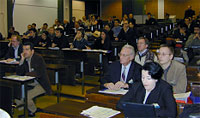 |
|||||||||||
|
|||||||||||
|
|||||||||||
|
The Electron Linear Accelerator Network (ELAN) is the specific branch of CARE that is used to support the ILC effort in Europe. ELAN has sponsored several workshops on key issues for the ILC, in particular the meeting that took place in June in London, England. In the future, ELAN will bridge the CLIC/CTF and the ILC activities (such as beam dynamics, alignment, feedback), encourage and participate in outreach activities and industrial forums, and follow up on the GDE effort. “Thanks to EU flexibility, it was possible to support meetings outside Europe, which is necessary in the framework of the international GDE”, said Francois Richard, Physicist from LAL and ELAN coordinator. He also stressed that several ELAN’s deliverables coincide with the needs of the GDE. For future ILC decisions, ELAN’s current role naturally leads to a design a programme for the “after CARE” period. As for the broader future for CARE, in a recent interview Aleksan said that the future Framework Programme 7 (FP7) will hopefully be approved soon and that the first calls for proposals could be made near the end of 2006. (The FP is the EU's main instrument for research funding in Europe. FP7 will cover a period of seven years and should start in 2007). “Next year, a part of our time will be dedicated to elaborate new proposals for this Framework Program”, he said. The schedule and the procedure to apply for FP7 “Research infrastructures”, in which CARE activities would fit, was detailed by European Commissioner Daniel Pasini by the end of the meeting. The CARE05 agenda highlighted new developments and research in each type of the accelerators activities (related to neutrino beams, linear colliders or proton accelerators). Attendees could follow dedicated and detailed presentations on their own field of interest during parallel sessions. CARE05 slidesCARE05 photos --Perrine Royole-Degieux |
|||||||||||
| © International Linear Collider |
